Technique - Quick-charging Sony NP-F970 battery-copies
A word upfront
In this article I will be charging lithium-batteries of unknown quality, by using a charger that can supply far more current than the original one. These batteries are dangerous and their life can come to an explosive end.
I expect you know what you are doing, have an understanding of electronics and the dangers of these batteries and won't take risks.
Though I mention 'Sony' batteries in this article, I seriously recommend AGAINST charging original Sony NP-F batteries this way.
Do NOT even think about charging the NP-F550 and NP-F770 batteries this way! Charging current is too high!
NP-F batteries for camera's and videolights
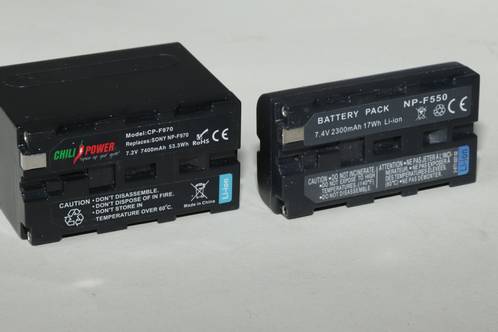 When you use videolights, just like me, there is quite a chance that they use so-called NP-F batteries.
When you use videolights, just like me, there is quite a chance that they use so-called NP-F batteries.
These rechargeable batteries, originally designed by Sony, are available in different sizes and therefor different maximum currents. They can power almost anything from camera to videolight.
Like many batteries, you can get copies of the original Sony-ones.
In my opinion, that isn't all bad.
Although there is quite a chance that the cells in a real Sony-battery are far better quality than the ones in a copy, they are a cheap alternative when you need a lot and the quality isn't the most important.
A sketchy charger
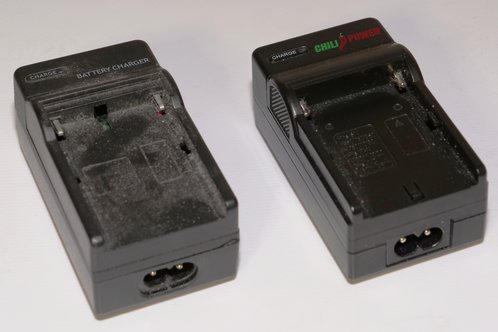 Problems really start with the charger. Different manufacturers, one just as doubtfull as the other, offer these chargers, often supplied with the battery or as an accesory with a videolight.
Both Falcon Eyes as Chilipower is now known to me. The picture shows that they hardly differ.
Problems really start with the charger. Different manufacturers, one just as doubtfull as the other, offer these chargers, often supplied with the battery or as an accesory with a videolight.
Both Falcon Eyes as Chilipower is now known to me. The picture shows that they hardly differ.
These chargers are of dubious quality. They get pretty warm when charging a small NP-F550 battery, but the most important thing is that the charger is unsafe when it comes to the electronics.
The spring-loaded contacts on the housing that meet the NP-F slide-on cradle, are located very close to the transformer inside and thus at a very short distance from mains power.
The 10 (or something) hours it takes to charge a NP-F550 is not a problem (for me). The maximum current is limited to 600 mA (if the charger can even get to that point). That's fast enough for me and I usually can spare that time.
Charging the NP-F970: Hours? Days!
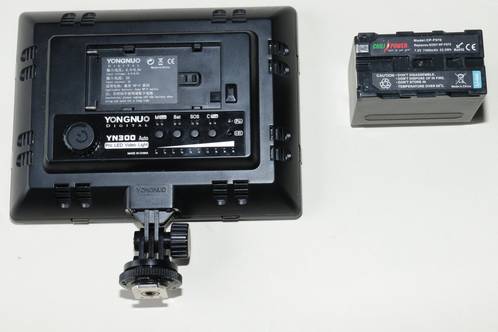 The far bigger NP-F970's I got when I bought my (second-hand) videolights, really posed a problem with the charging time.
The far bigger NP-F970's I got when I bought my (second-hand) videolights, really posed a problem with the charging time.
According to the marking on the battery, these can supply 7400 mAh although I don't believe that rating completely.
A NP-F550 I once opened proved to have cells capable of delivering 1800 mAh only, while the sticker said it could deliver 2200 mAh. A comparable model made by Swit, the better brand among battery-copies, also provides a rating less than the 7400 mAh (6600 mAh), so that says something.
The two identical, cheap chargers, are as good as worthless.
Charging took ages. I'm a fan of charging a battery slowly instead of pumping it full with current in just a few hours, but the 36 to 48 hours it took the small charger to fully charge them was too much for me.
Besides that, the charger got incredibly hot. I kept a fan blowing over them as I was afraid it would end in disaster otherwise.
Quick-charging with home-built stuff?
With only 3 chargers, 4 big batteries and multiple small ones, I decided I needed someting different. In a worst-case scenario I had to start charging batteries days before I would need them.
I found a better charger, but only at the other side of the ocean.
Together with import-taxes and shipping, the price went over 100 US-dollar, which I found to be a sturdy pricetag.
DIY-stuff it is then and on the hunt for circuit-diagrams. The downside is that lithium-ion batteries aren't easy to charge.
Charging starts with a constant current and is then followed by a constant voltage, after reaching a certain threshold-voltage.
At a particular voltage (usually 4,2 Volt for 1 cel) the charger MUST stop charging. Even going over this limit by a tenth of a Volt is bad for the batteries life-expectancy and heightens the risk of fire and possible explosion.
Finding a circuit that would be relatively easy to built myself, proved to be hard. Very basic circuits, capable of charging only 1 type of battery or that used an IC that was almost impossible to source, remained.
If the IC was possible to obtain, it was a package that I consider to be impossible to process for the average amateur, as the IC would come in a kind-of BGA-like package.
Partial do-it-yourself: Ebay or?
Ebay provides all kinds of materials to charge Li-ion batteries or make your own batterypacks.
Considering the time you need to wait before your order arrives and the dubious quality, I wasn't too fond of ordering there.
In equipment I built myself, I was thinking of exchanging the heavy 12 Volt 5 Amp lead-acid battery with a lithium-battery, thus I browsed the products at Nkon.nl. Single cells were not the problem, charging them and the necessary BMS were.
The batteries I want to charge, are configured in a so-called '2S3P' configuration. This means that 2 cells are connected in series. In reality, every individual cell consists of 3 cells connected in parallel.
Electrically speaking, cells connected in parallel become 1 and the current is divided across them automatically.
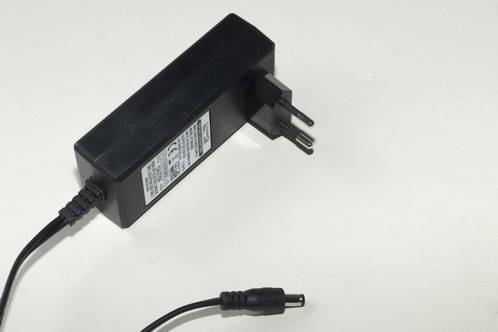 While browsing, 'bicycle chargers' caught my eye. Small chargers available in different voltage- and current-ratings.
While browsing, 'bicycle chargers' caught my eye. Small chargers available in different voltage- and current-ratings.
There was a 8.4 Volt 3 Ampère type there as well, the Fuyuang (Enerpower) FY0853000.
And that was interesting. That is the same voltage the NP-F batteries have when fully charged and the maximum current from the charger is roughly equivalent to the nominal current of 1 cell in a NP-F970 battery (7,4 Amp divided by 3), considering the ratings are at least slightly trustworthy.
I bought this charger, just to see where I would end up.
Extraordinary charging...
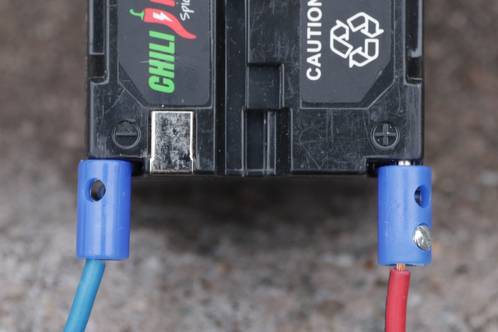 Connecting such a rechargeable battery is slightly problematic when you want to fiddle with them and don't want to sacrifice a charger for the socket straight-away. Luckily, mini banana-plugs as used in modelrailroading provide a suitable connection and this covers the most important bit.
Connecting such a rechargeable battery is slightly problematic when you want to fiddle with them and don't want to sacrifice a charger for the socket straight-away. Luckily, mini banana-plugs as used in modelrailroading provide a suitable connection and this covers the most important bit.
I made some short leads to put my multimeter in series with the chain and was ready to charge.
Caution! Because of batteries and multimeter
Lithium batteries are not the safest batteries. The current these cells can deliver in a short-circuit condition are huge and charging and discharging has to be monitored in a precise manner to prevent the cell from getting hot or (in a worst-case scenario) explode.
This case involves a second risk: the cells in the Sony NP-F battery-copy are of unknown quality. I don't know what the exact capacity is and this also means it's hard to guess if the maximum charge current will be exceeded.
Also important: This charger is ONLY MEANT to charge the NP-F970 type batteries.
DO NOT use this charger to charge the smaller NP-F550 and NP-F770, as the charger most likely exceeds the maximum charge current.
Do not take any risk and test this first with a COMPLETELY DISCHARGED battery, and charge it OUTSIDE.
This is the worst possible condition which will get the highest current going.
Make sure that the battery is placed on a relatively heat-resistant surface and keep (in case you go for a very thorough approach) a fire-extinguisher close at hand.
DO NOT USE WATER AS AN EXTINGUISHING AGENT! LITHIUM REACTS WITH WATER!
Pay attention to the multimeter used! My model (Multimetrix DMM220) measures current without causing a voltage-drop. However, there are devices who measure current by measuring the voltage-drop across a resistor inside the meter. This voltage-drop could confuse a lithium-batterycharger trying to sense the state-of-charge of the battery.
Check this before you use it in series with the battery to be charged.
A current-clamp is no problem.
Backyard charging
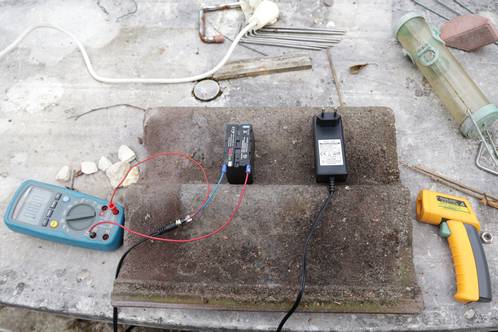 To minimise possible consequences, I started to work in the garden, with measures mentioned above taken.
To minimise possible consequences, I started to work in the garden, with measures mentioned above taken.
A shingle on the gardentable, the multimeter in the current-measuring range and my temperature-gun
were close at hand.
The battery was connected to my multimeter and I than plugged the charger into a socket. I connected the battery with the charger. That was quite eerie, as the full 3 Amp charge-current was being drawn for nearly 30 minutes.
After 30 minutes, current had dropped with about 130 mA and after 45 minutes, current had significantly gone down to 2,3 Amp. After 105 minutes, current was down to 1,2 Amp.
Though the battery had plenty of air-cooling, I did check the temperature for about 45 minutes at every possible spot.
Temperature went up to 32 degrees Celsius at most. I then stopped checking, as I did not expect further increase.
 After approximately 4,5 hours, the green 'charging complete' indicator lighted, also noting that it had gone into constant-voltage mode.
After approximately 4,5 hours, the green 'charging complete' indicator lighted, also noting that it had gone into constant-voltage mode.
Completely according to specification, current was below 0,3 Amp.
If you disconnect the charger at that point, batteryvoltage will be around 8 Volt. If you keep the charger connected, it will eventually reach the maximum 8,4 Volt.
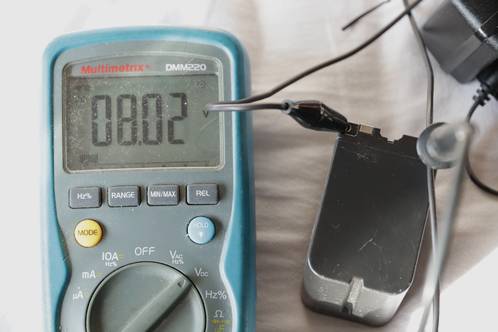 It's unlikely I will notice this small difference when in use. The cells will like it, as they won't have such a hard chemical time at 4 Volt per cell compared to 4,2 Volt per cell. This results in a longer overall lifespan, but it will provide less time to use the battery.
It's unlikely I will notice this small difference when in use. The cells will like it, as they won't have such a hard chemical time at 4 Volt per cell compared to 4,2 Volt per cell. This results in a longer overall lifespan, but it will provide less time to use the battery.
It's a nice thought anyway that I can now charge 4 fully depleted batteries in about 24 hours instead of 10 days...
Now I only need to make a safer charging-dock...